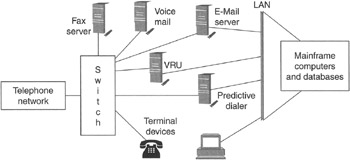Chapter 3: Organizing and Managing the Call Center
|
|
You don't know what you don't know until you know it... the right solution is a continuous search for the right solution.
Dr. Ichak Adizes
3.1 Overview
The turn of the 20th century was the dawn of a new age in communications. A few decades earlier, in 1876, the telephone had been invented and telephone service was proliferating rapidly. As telephone services expanded, the public began to depend on and even expect reliable service from telecommunication providers.
As the subscriber base grew, telephone companies were contending with new resource-planning problems. Automated central offices hadn't yet been invented, so human operators were required to establish connections for callers. One big question was how many telephone operators were necessary to run the switchboard. Too few and service levels would be unacceptable to callers. But too many would be inefficient for telephone companies and would drive up costs for subscribers. Further complicating the issue was the fact that calls arrived randomly, driven by the myriad of motivations individual callers had for placing calls. (see Figure 3.1)

Figure 3.1: Typical call center infrastructure.
In the years that followed, many bright people would grapple with these resource-management challenges. One of the first was A. K. Erlang, an engineer with the Copenhagen Telephone Company, who in 1917 developed the queuing formula Erlang C. The formula is still widely used today in incoming call centers for calculating staffing requirements and is described in greater detail later in this chapter. Others who followed Erlang focused on developing disciplined forecasting techniques, scheduling methodologies, and system report parameters; advances in the development of forecasting and scheduling methodologies continue to be made.
The management challenge
Managing a call center operation successfully requires a multitude of skills-managerial, troubleshooting, negotiating, and patience, not to mention a personality that works well under pressure and is able to handle the different types of CSRs who will work at the facility over time. Some familiarity with computer and communications technologies is an asset as well, although most internal call center facilities should have ready access to technical support for resolving hardware, software, and communications problems. The steady growth in the call center industry over the past 10 years has resulted in a requirement for new job-related management skills. As call center personnel have developed these skills, the position of call center manager has evolved and is now a portable, definable position, recognized from company to company and across different sectors of industry.
The global growth of call centers as a significant element of customer-centered business has led to the employment of a large number of people in call centers, estimated to be between 3 and 4 million, in North America alone. From a labor market perspective, the industry is not saturated, since the growth of call centers outpaces the supply of employees. Historically, the industry has had a difficult time attracting a steady supply of qualified workers. Turnover in the call center industry is a major problem as well. Turnover rates are significantly higher than those of other industries. A recent benchmarking study of call centers by the Purdue University Center for Customer-Driven Quality found that turnover is an industrywide problem. The survey revealed that inbound centers have an average annual turnover of 26% for full-time reps and 33% for part-timers. Nearly half of the centers said that part-timers handle 5% or less of their total calls.
This book cannot solve the turnover problem, nor can it make more employees available to the call center industry. However, in the context of the axiom that "good management of human resources means happy, long-term employees," the guidelines and experiences of successful call center managers, as presented in this chapter and in Chapter 5 can assist new and existing call centers to manage the human resources that are so essential to their success.
Rising staff costs
Faced with the requirement of generating a profit, many businesses confront a major problem: rising staff costs. Over the next few years, management of call/contact center staff will move to the forefront of corporate concerns because
-
The average call/contact center spends between 60 and 70% of its annual budget on staff salary.
-
Globally, agent turnover rates average 22%, and approach 50% in some industries.
-
Staff absenteeism is increasing and is as high as 17% in the health care industry, 10% in the telecommunications and consumer products markets, and averages 9% across all vertical markets.
-
Over 80% of companies use external advertisements to search for agents and 72% use recruitment agencies, both of which involve significant costs.
-
Call/contact center location clustering is increasing and has caused severe shortages of qualified staff in places such as Dublin (Ireland), Omaha, Nebraska (United States), New Brunswick (Canada), and Amsterdam (The Netherlands). In most countries with major call/ contact center clusters, recruitment is becoming very difficult.
-
There has been a rapid increase in the growth of the call/contact center industry.
-
The growth of CRM and multimedia interaction will require skilled and experienced agents, and training costs will increase accordingly.
|
|
EAN: 2147483647
Pages: 90